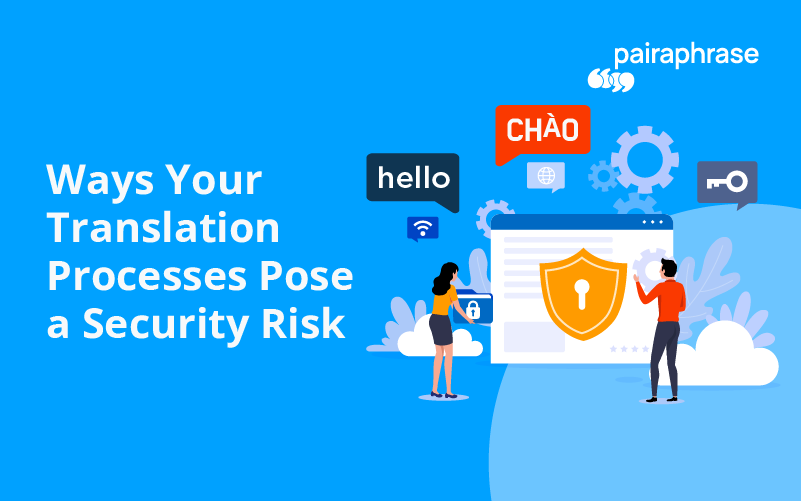For IT managers performing security risk assessments, translation processes might not be top of mind. However, translating business documents and internal communications pose more enterprise cybersecurity risks than you may think.
In order to close data security gaps in translation processes, evaluate your company’s use of the following language translation activities. You might be surprised to find that there are multiple ways employees might be unknowingly exposing your company’s sensitive data.
These 5 Translation Activities Pose a Risk to Data Security
1. Machine translation without a “no return” clause
“Data return” to machine translation engines is likely the most widespread security threat within your company’s translation process.
When your employees use Google Translate or other free online translation services, they’re likely giving those companies the right to repurpose, share or index your inputted data.
What To Do
Seek out a secure CAT (computer assisted translation) tool that allows your employees to use machine translation framework to generate first-draft translations without making your data accessible to these providers. The same goes for the storage of uploaded files.
2. Sending files for translation via email attachment
One way to reduce risk in language translation processes is to encourage all collaboration to take place in one centralized hub.
People who collaborate on translation projects often make the mistake of emailing file attachments to each other for edits and translation requests. The same goes for instant messaging through external applications.
What To Do
Find a secure translation platform with a strong project management component. This will enable teams to collaborate effectively with all the tools they need while centralizing their translation data AND increasing productivity.
3. Disregarding user permission controls
When companies use online translation software without user permission controls, you risk those files falling into the hands of unauthorized people or inboxes.
What To Do
If your company is already using translation software that helps your teams centralize their projects, be sure that user permission controls are in place. If the software doesn’t offer those controls, it’s time to consider an alternative solution.
4. Not using translation memory group permissions
Not using translation memory group permissions might be exposing your data (or client data) to unauthorized users within your account.
About Translation Memory
“Translation memory” technology is typically available in popular professional CAT tools. It’s what allows users to enhance their productivity during the translation process by by storing and reusing previous translations.
“Translation memories” are machine translation segments that have been post-edited by your company for quality improvements and then saved in a bilingual central repository for future recall.
“Translation memory groups” help you keep stored translations separated by department (or client, if your company is an agency). Some translation applications allow you to restrict a user’s accessibility to specific translation memory groups.
This is particularly useful for keeping specific project or departmental data private to designated users. It helps these teams keep machine-learned translations separate.
What To Do
Mitigate risk in translation processes by making sure translation memory group permission controls are in place. If your company’s software doesn’t supply those controls, seek out an alternative solution.
5. Using online translation software without:
- SHA-2 and 4096-bit encryption
- 256-bit SSL certification
- Encrypted file storage in transit, in use and at rest via AWS
- “No Return” to machine translation providers
- PCI-compliant payment processing via Stripe
- HIPAA, SOC1 and ISO27001 compliant datacenters
- Multi-Factor Authentication
- TLS 1.2 (Transport Layer Security)
- Last login date and time display in footer
- Automatic session logoff if idle for more than 30 minutes
- Password expires after one year
- Auto-lock after 4 failed password attempts
- Device Authentication
- Compliant with GDPR & HIPAA
- Single Sign-On
- Supports secure browsers; Chrome, Firefox, Edge & Safari
- Third-party security audit & assessment records
What To Do
Find a secure translation application with all of the above security measures.
How to Mitigate Risk Using One Translation Application
Want to mitigate all the translation security risks outlined above with just one solution?
Try Pairaphrase. It’s a web-based translation management system for enterprises who value safer, smarter and faster translation.
or share this article with a colleague.

.png)

.png)




